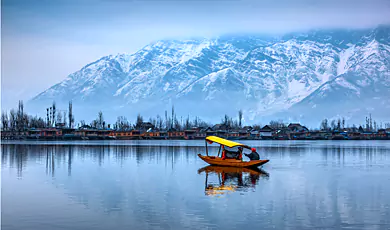
India is home to numerous stunning lakes, many of which are scenic and play important roles in the ecosystem and local economies. India's biggest lake, Vembanad, located in Kerala, is a vast water body that stretches across several districts. It is a crucial hub for the region's fishing industry and a UNESCO-recognized wetland. The lake attracts tourists for its serene backwaters and houseboat cruises, making it a must-visit destination for nature lovers and adventure enthusiasts. Among the largest lakes in India, the Chilika Lake stands out as one of the most important ecosystems. Situated along the eastern coast of Odisha, this brackish water lagoon is the second-largest of its kind in the world. It is known for its diverse bird species, especially migratory birds, and its significance in supporting local communities with fishing and tourism. The lake's beauty and ecological importance make it a prime spot for nature lovers and environmentalists.
India’s biggest lakes in India include the famous Dal Lake in Jammu and Kashmir. This picturesque lake, with its floating gardens and houseboats, is an iconic symbol of the Kashmir Valley. Dal Lake attracts thousands of visitors annually, blending cultural heritage and natural beauty. The lake also plays an essential role in the region's water supply and irrigation, making it an integral part of the local environment and economy. When considering the largest lakes of India, the Sardar Sarovar Lake in Gujarat stands as one of the top contenders. Created by the Sardar Sarovar Dam on the Narmada River, this reservoir is crucial for water supply, irrigation, and hydroelectric power generation. The lake and its surroundings offer a beautiful landscape, attracting tourists and locals for boating and nature walks. Lastly, the biggest lake of India, the Wular Lake, located in Jammu and Kashmir, is another significant water body. It is one of Asia’s largest freshwater lakes and is essential in controlling floods and providing water to the local agriculture. Known for its scenic beauty, Wular Lake also supports various species of birds and wildlife, making it an ideal spot for nature enthusiasts.
| Sr. No. | List of Biggest Lakes of India | More Information |
|---|---|---|
| 1 | Pulicat Lake | |
| 2 | Vembanad Lake | |
| 3 | Pangong Tso | View more |
| 4 | Dal Lake | |
| 5 | Pichola Lake | |
| 6 | Hussain Sagar Lake | |
| 7 | Sukhna Lake | |
| 8 | Tso Moriri Lake | View more |
| 9 | Tsomgo Lake | |
| 10 | Ashtamudi Lake | |
| 11 | Chilika Lake | |
| 12 | Dhebar Lake (Jaisamand Lake) | |
| 13 | Kolleru Lake | |
| 14 | Loktak Lake | |
| 15 | Lonar Lake | |
| 16 | Renuka Lake | |
| 17 | Sambhar Salt Lake | |
| 18 | Suraj Tal | |
| 19 | Upper Lake (Bhojtal) | |
| 20 | Wular Lake |























